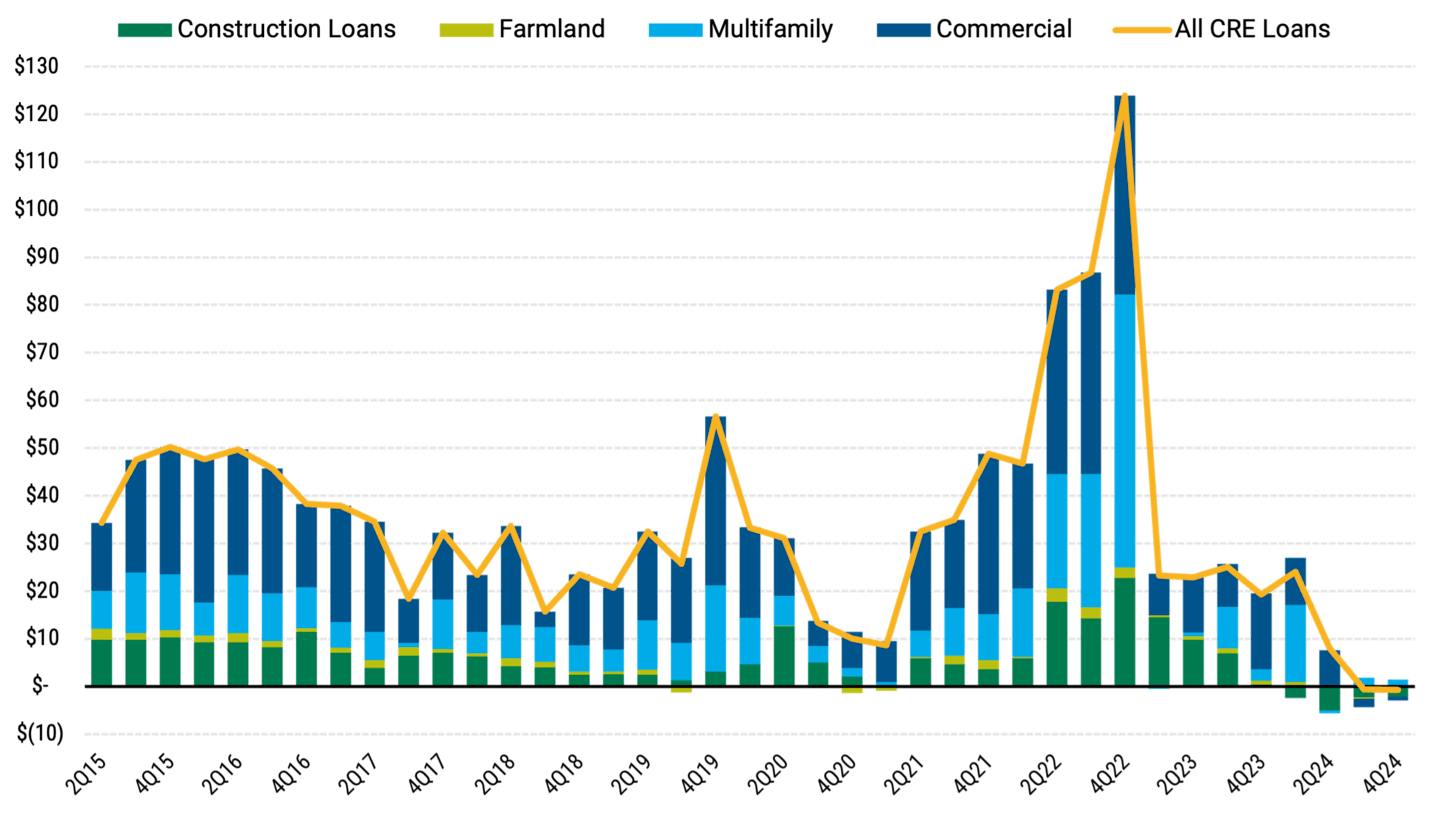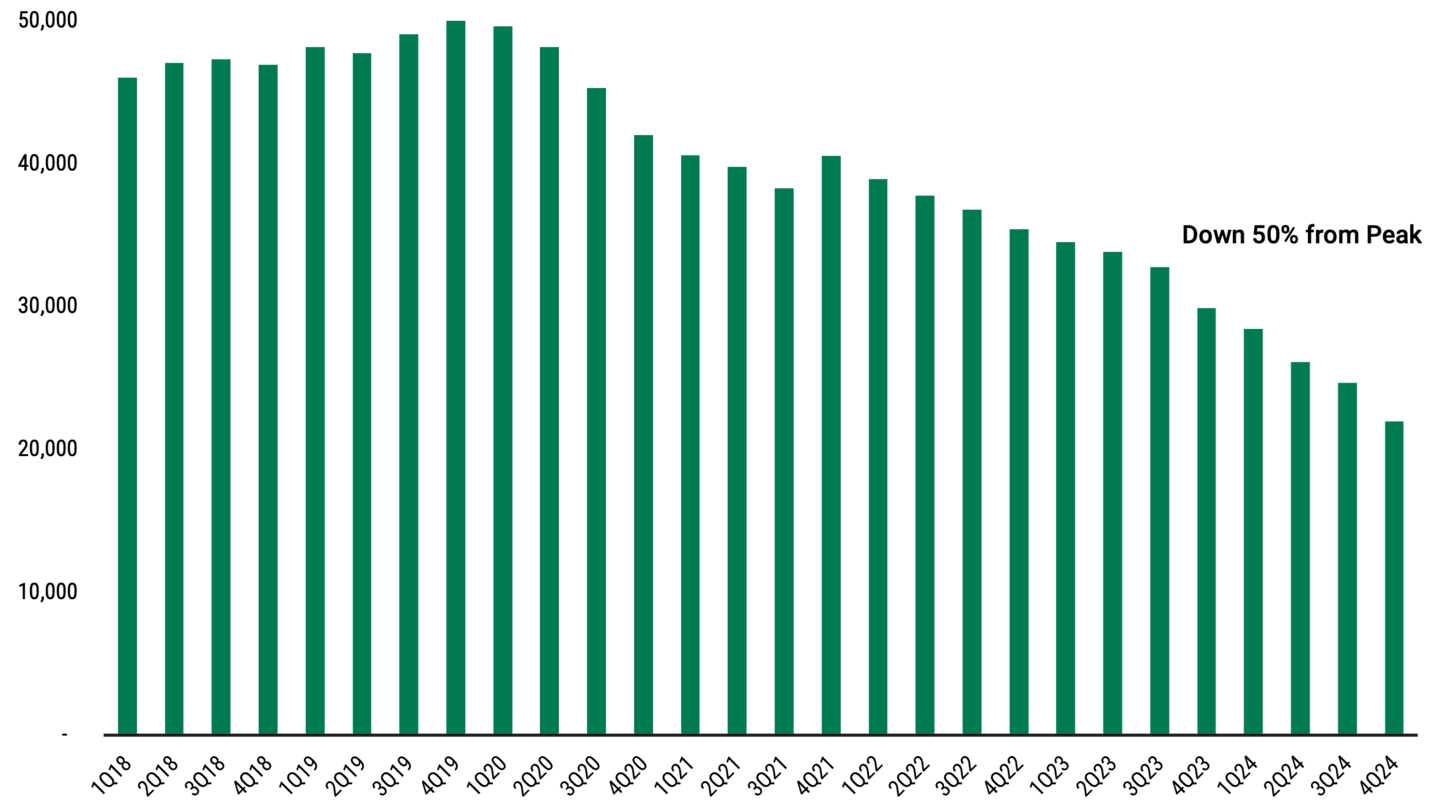Why We Think Real Estate May Provide Opportunities in a Stormy Environment
Much like the broader market, certain areas of the real estate sector perform better than others. In 2025, listed REITs have outperformed broader equity indices and generated notable excess returns.

Key Takeaways
Real estate investment trusts are relatively insulated from tariffs and entered this period of volatility with stable earnings and attractive valuations.
Even in an unstable market, we believe a lack of supply will continue to support real estate performance.
The possibility of lower interest rates this year may bolster the case for real estate investment trusts.
After U.S. markets sailed through 2023 and 2024 on the strength of investment themes like artificial intelligence (AI) and the Magnificent Seven, unforeseen shocks have upended the investment world in 2025.
In early 2025, markets were already jittery due to concerns about slowing economic growth and doubts about the level of investment in AI. Then, in April, the Trump administration’s unexpectedly severe tariff program sent markets into historic turmoil, triggering a shift in market leadership.
Amid this market unrest, investors have rediscovered the real estate sector, specifically listed real estate investment trusts (REITs). So far in 2025, listed REITs have outperformed broader equity indices, generating notable excess returns. See Figure 1.
Figure 1 | REITs Have Outperformed Stocks Over the Last Year
3 Months | YTD | 1 Year | ||
FTSE Nareit All Equity REITs Index | U.S. REITs | -0.30 | 0.72 | 16.27 |
S&P 500® Index | U.S. Equities | -7.50 | -4.92 | 12.10 |
Excess | 7.20 | 5.64 | 4.17 | |
S&P 500® Developed REIT Index | Global REITs | -0.36 | 1.34 | 13.45 |
MSCI World Index | Global Equities | -4.17 | -0.77 | 12.64 |
Excess | 3.81 | 2.11 | 0.81 |
Data as of 4/30/2025. Source: Morningstar, FactSet. Past performance is no guarantee of future results.
The environment for listed REITs was favorable coming into 2025. Demand for real estate across several industries has been strong, but as Figure 2 shows, banks' reluctance to make loans for commercial real estate (CRE) ventures has limited the availability of new supply.
We expect market volatility to intensify the supply-and-demand imbalance, as economic uncertainty further limits the willingness to initiate new real estate projects.
Figure 2 | Tight Lending Conditions Constrain New Supply

Data as of 12/31/2024. Source: Federal Reserve and KBW Research, H.8 Assets and Liabilities of Commercial Banks in the United States.
Market volatility caused by tariff policies is challenging to navigate and can change at any time. However, we think there’s a potential silver lining: We expect the economy to slow enough to alleviate the risk of higher inflation arising from these trade policies.
Strategic Real Estate Positioning Amid Market Turbulence
Much like the broader market, certain areas of the real estate sector perform better than others. We have observed significant differences this year among real estate winners and losers. As of April 30, cell tower and health care REITs were among the winners, up 14% and 9.3%, respectively, according to FactSet. The losers include lodging/resort and office REITs, down 22.6% and 14.8%, respectively.
The Growing Demand for Senior Housing
When we examine the health care industry closely, we see that senior housing is a significant factor behind its success. This category has thrived due to a notable imbalance between the supply of housing options and the growing demand from older adults. Properties range from independent living developments to skilled nursing facilities.
Figure 3 illustrates the rapid increase in the number of U.S. adults turning 65, the inevitable outcome of demographics. Meanwhile, Figure 4 shows that the number of new senior housing units coming on the market each year has been declining, primarily due to high interest rates that hinder financing new projects.
As a result, owners of existing senior housing facilities have significant pricing power, which is why we are overweight in the broader health care sector.
Figure 3 | The Number of People Turning 65 Is Soaring

Projections as of 2020. Source: U.S. Census Bureau.
Figure 4 | The Number of New Senior Housing Units Is Dwindling

Data from 1/1/2018 - 12/31/2024. Source: NIC MAP Data Service, Evercore ISI Research.
The State of Residential Real Estate in 2025
We have also increased our portfolio weights in residential real estate, given the high demand for multifamily and single-family housing alongside a lack of new supply.
At the same time, we have reduced our investments in certain areas of real estate that we expect will continue to underperform. Given the uncertain economic conditions, there is expected to be less demand for travel, which has led us to decrease our holdings in hotel and lodging REITs. Similarly, slowing economic activity will likely diminish demand for office and industrial real estate, so we have reduced our exposure to REITs in these subsectors.
Three Tailwinds for REITs
We believe three key factors may lead to continued REIT outperformance in this choppy economic environment.
Lack of Supply
High interest rates and increasing construction costs have made it hard for developers to forge ahead with new projects. Broadly speaking, 80% of listed REITs have experienced lower supply growth over the last five years, according to American Century Investments research. However, demand has continued to rise in sectors like health care, resulting in strong pricing power for current owners.
Attractive Valuations
Stocks that trade at a bargain are often among the best positioned relative to others at the beginning of a period of market turmoil. Shares of listed REITs have traded at a significant discount to broader equities over the last year. We think this could help REITs as investors may find relative stability in certain corners of the real estate sector and buy at an affordable entry point.
Interest Rates Trending Down
While interest rates are volatile and the unpredictable nature of the current market environment muddles the Federal Reserve’s (Fed’s) decision-making, we believe rates will likely fall over the year. The tariff situation remains uncertain, but we suspect the economy will slow down regardless of trade policy.
We think a slowing economy could allow the Fed to cut interest rates. Lower rates, along with lower shelter inflation, could offset inflation spikes brought on by U.S. tariff policies, further benefiting listed REITs.
Why REITs Can Thrive in a Slowing Economy
Investors who recall REITs underperforming in the lead-up to the Great Financial Crisis may be concerned about taking positions in this asset class. However, we think it’s worth pointing out that REITs today have better balance sheets and hold less debt than in 2008.
We expect REITs to continue to perform well relative to broader equities in this unstable market environment. REITs had the advantage of entering this market phase at attractive valuations, which has historically benefited this asset class.
Authors
Client Portfolio Manager
Senior Portfolio Manager
Portfolio Manager
Explore Our Real Estate Capabilities
Investment return and principal value of security investments will fluctuate. The value at the time of redemption may be more or less than the original cost. Past performance is no guarantee of future results.
The opinions expressed are those of American Century Investments (or the portfolio manager) and are no guarantee of the future performance of any American Century Investments portfolio. This material has been prepared for educational purposes only. It is not intended to provide, and should not be relied upon for, investment, accounting, legal or tax advice.
No offer of any security is made hereby. This material is provided for informational purposes only and does not constitute a recommendation of any investment strategy or product described herein. This material is directed to professional/institutional clients only and should not be relied upon by retail investors or the public. The content of this document has not been reviewed by any regulatory authority.
References to specific securities are for illustrative purposes only and are not intended as recommendations to purchase or sell securities. Opinions and estimates offered constitute our judgment and, along with other portfolio data, are subject to change without notice.